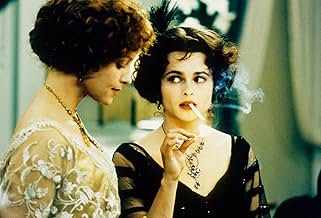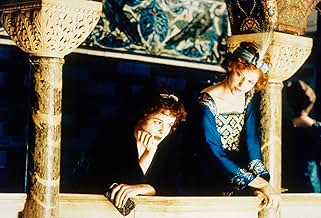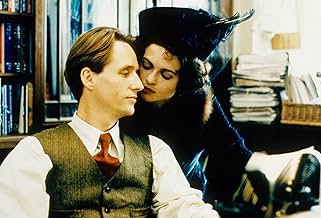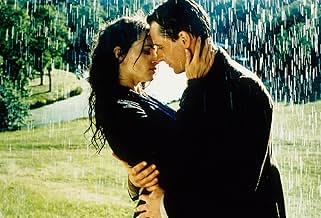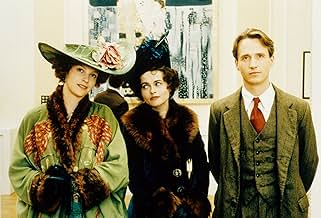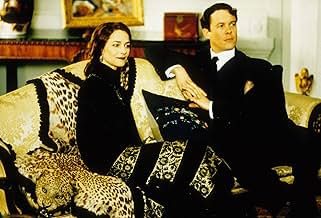VALUTAZIONE IMDb
7,1/10
13.366
LA TUA VALUTAZIONE
Una donna impoverita che è stata costretta a scegliere tra una vita privilegiata con la sua ricca zia e il suo amante giornalista fa amicizia con un'erede americana.Una donna impoverita che è stata costretta a scegliere tra una vita privilegiata con la sua ricca zia e il suo amante giornalista fa amicizia con un'erede americana.Una donna impoverita che è stata costretta a scegliere tra una vita privilegiata con la sua ricca zia e il suo amante giornalista fa amicizia con un'erede americana.
- Regia
- Sceneggiatura
- Star
- Candidato a 4 Oscar
- 16 vittorie e 32 candidature totali
Mark Chapman
- Royal Bodyguard
- (non citato nei titoli originali)
Gary Condés
- Man in Boat Queue
- (non citato nei titoli originali)
Royston Munt
- Carriage Driver
- (non citato nei titoli originali)
Guy Standeven
- Man in Bookshop
- (non citato nei titoli originali)
Recensioni in evidenza
It is London in 1910 and protagonist Kate Croy, a beautiful young woman, is living with her wealthy but controlling aunt. Kate has fallen in love with Merton Densher, a journalist of whom her aunt disapproves and forbids her to see. Her aunt is pushing her in the direction of the 'more suitable' Lord Mark. When wealthy young American heiress Milly Theale arrives on the scene Lord Mark informs Kate that Milly is dying and he intends to marry her for her money, to save his estates, before returning to Kate... Kate decides Merton should be the one getting close to Milly so, during an extended holiday in Venice guides them together... there is a risk though; what if he falls in love with her?
I've not read the book on which this film is based so can't say how they compare; but as a work in its own right I really enjoyed it. The romance feels real, with Kate clearly knowing she is taking a risk... both that her aunt will disinherit her for seeing Merton and that he might genuinely fall for Milly. The setting is beautifully realised but never feels dated... which it shouldn't as whatever present one is in feels modern for those people in it. Helena Bonham Carter does a brilliant job in the role of Kate; she shows what Kate is feeling with the subtlest of expressions; she also makes it easy to sympathise with Kate even while she is being morally ambiguous. Linus Roache and Alison Elliott impress as Merton and Milly respectively and the rest of the cast is solid. The film looks great from start to finish as it moves from London to Venice. Overall I'd definitely recommend this to fans of period dramas.
I've not read the book on which this film is based so can't say how they compare; but as a work in its own right I really enjoyed it. The romance feels real, with Kate clearly knowing she is taking a risk... both that her aunt will disinherit her for seeing Merton and that he might genuinely fall for Milly. The setting is beautifully realised but never feels dated... which it shouldn't as whatever present one is in feels modern for those people in it. Helena Bonham Carter does a brilliant job in the role of Kate; she shows what Kate is feeling with the subtlest of expressions; she also makes it easy to sympathise with Kate even while she is being morally ambiguous. Linus Roache and Alison Elliott impress as Merton and Milly respectively and the rest of the cast is solid. The film looks great from start to finish as it moves from London to Venice. Overall I'd definitely recommend this to fans of period dramas.
There are two tests in my mind for a classic film.
First, it must plant some images permanently in your life. Very few films do that. Two films that are cogent to discussing this one are Helena Bonham Carter's Ophelia in Zefferelli's `Hamlet.' She and Glenn Close acted circles around the guys -- her expression in the midst of the play within the play is lasting over years in my memory. The whole film revolves around that moment.
Also lasting are several images from the ostensibly unambitious `Oscar and Lucinda.' But I also carry many lasting film images that are junk, courtesy of Lucas and Spielberg. That brings us to the second condition: for a film to be classic, evocation of the images, the remembrance, needs to be multidimensional, to elevate rather than dumb down.
Measured by those rules, this film is remarkable. For a few years, I have carried the image of the next to last scene where Carter makes love and in the act discovers the truth about her love. This is so wonderful, so tragic, so true that it has stuck with me, together with the secondary images, the memories of Venice and Millie that Merton is in love with. I hope to follow this woman's career for decades. I wonder where it will go?
First, it must plant some images permanently in your life. Very few films do that. Two films that are cogent to discussing this one are Helena Bonham Carter's Ophelia in Zefferelli's `Hamlet.' She and Glenn Close acted circles around the guys -- her expression in the midst of the play within the play is lasting over years in my memory. The whole film revolves around that moment.
Also lasting are several images from the ostensibly unambitious `Oscar and Lucinda.' But I also carry many lasting film images that are junk, courtesy of Lucas and Spielberg. That brings us to the second condition: for a film to be classic, evocation of the images, the remembrance, needs to be multidimensional, to elevate rather than dumb down.
Measured by those rules, this film is remarkable. For a few years, I have carried the image of the next to last scene where Carter makes love and in the act discovers the truth about her love. This is so wonderful, so tragic, so true that it has stuck with me, together with the secondary images, the memories of Venice and Millie that Merton is in love with. I hope to follow this woman's career for decades. I wonder where it will go?
In this most affecting adaptation of Henry James's dense and difficult novel, Ian Softley brings passion back to the oft-derided genre of "period" movie. There are many angles in the story; tales of deception, social hypocrisy, conflict between our hearts' desire and our conscience, of regrets, and some degree, of just deserts. However, in the heart of it lies an unforgettable love triangle, fuelled by the amazing performances of the three leads. Helena Bohnam-Carter, in the pinnacle of her career, embodies the fierce intelligence and ruthless determination of Kate Croy, a woman born in a wrong era, whose effort to hold on to both love and wealth tragically backfires. Linus Roache, playing Kate's secret love, brings tortured Merton Densher (where does James come up with these names?) vividly to life. He has the sort of intense good looks and physical presence required for this role in spades; and his dramatic ability shines though, especially in his last scene with Millie, where he acknowledges his duplicity before the all-accepting love of the dying girl with an incredible raw emotionality. I was most impressed with Allison Elliot's Millie, however. The angelic Millie could have been a big cliché of a character, but in Elliot's skillful hands, Millie takes on the luminance of spirits and love of life that grow even as her physical strength fails. The story and the actors are tremendously aided by gorgeous cinematography (especially the mournful beauty of rain-soaked Venice) , costumes-to-die-for by Sandy Powell (who wore that fabulous red dress to this year's Oscar, accepting the award for "Shakespeare in Love". She should have won it for this film), and beautiful music. A movie to be watched in a dark rainy afternoon, and savored like fine wine.
This was not one of my favorite novels when I read it (for James, I prefer THE PORTRAIT OF A LADY), but this is a very good film. Director Iain Softley and writer Hossein Amini made the smart decision to move this up in time to the 1910's, which enables them to get to the passions more than James does here. Softley also makes this darker than most literary adaptations, in look and in tone, without suffocating it, and he avoids making this a film about production design rather than about a story. He does labor a bit in trying for tragedy, but that's only a quibble.
Alison Elliot, a good actress (I liked her in THE UNDERNEATH and the otherwise flawed THE SPITFIRE GRILL), takes awhile to warm up as Millie, because she seems a little too modern, but she avoids easy sentiment as the dying heiress. Linus Roache, who I thought was a little awkward in PRIEST, here avoids the trap of being the third wheel, making us understand what both Millie and Kate see in Merton. But the real triumph here is Helena Bonham Carter, who gave the best performance of the year. One character says of Kate, "There's something going on behind those beautiful lashes," and that can usually be said of the characters Carter plays, but sometimes she's overly detached. Here, she's completely engaged, and she pulls off the difficult trick of never losing our sympathies even when her character does something despicable. And where James sort of made Kate just manipulative, Carter makes her human and longing.
Alison Elliot, a good actress (I liked her in THE UNDERNEATH and the otherwise flawed THE SPITFIRE GRILL), takes awhile to warm up as Millie, because she seems a little too modern, but she avoids easy sentiment as the dying heiress. Linus Roache, who I thought was a little awkward in PRIEST, here avoids the trap of being the third wheel, making us understand what both Millie and Kate see in Merton. But the real triumph here is Helena Bonham Carter, who gave the best performance of the year. One character says of Kate, "There's something going on behind those beautiful lashes," and that can usually be said of the characters Carter plays, but sometimes she's overly detached. Here, she's completely engaged, and she pulls off the difficult trick of never losing our sympathies even when her character does something despicable. And where James sort of made Kate just manipulative, Carter makes her human and longing.
The Wings of the Dove (1997)
Yes, this is a quite, indirect, thoughtful movie. But it is never slow. And the acting is incredible, almost as incredible as all the dresses and interior sets, which will blow anyone's mind. The story, by Henry James (the master of indirect but probing feelings), is about love of all kinds. And about being a good person, really. Three of the four main leads struggle with doing the right thing (and they do the right thing). The fourth struggles, falters, then comes forward again, then falters, finally, by making a demand that can never be met.
It's unfair to compare this kind of period movie (set around 1910 even though James's book was published in 1902) to "A Room with a View" (set in the same decade) but the reason this happens is that the 1985 Merchant-Ivory masterpiece seemed to open up a new way of making period films, filled with beauty and lingering thoughts and, well, feeling. Not the feeling two people have for each other, but a feeling of a time and place. It so happens the star of this 1997 film, Helena Bonham Carter, also starred (magnificently) in the first one.
The other star is a man, Linus Roache, who almost overplays his understated character by making him dry and deadpan and polite. But it works, over time, to help make the final few seconds of the film (which are so important) succeed. The third lead, really, in this lopsided triangle, is Alison Elliott, who puts in an equally subtle performance. So much of the movie is about little changes in facial expression, the acting had to rise to the needs of the plot. Bonham Carter, above all, does this with chilling perfection.
But those dresses! This is what is called Edwardian England, the first decade of the 20th Century, a time when modernity swept Europe with a passion (Picasso and Klimt) and when cars and other new technologies were surging. The styles of the dresses are part Art Nouveau, with its Asian influences, and part European excess, a showing off of style and wealth and material sensibility. Thank god! It's just breathtaking. The interiors are likewise brimming with tiles and flowers and paintings and light of all kinds.
All of this is handled with a cinematic control that reminds me of the color coordination of mid-century Technicolor films, where the palette of a scene is often limited to a pair of colors. You'll see many scenes where a mix of blue and rusty orange are the only two colors in various guises (and these are most common because of the hair and eyes of Elliott). The cinematography is by Eduardo Serra, one of a handful of the most sumptuous contemporary shooters in film ("Girl with the Pearl Earring" and "What Dreams May Come"). And he lets the light and color inhabit every scene, never letting the photography get in the way. Just beautiful.
So what does it mean to be a good person? Who cares with all this great acting and beautiful filming? But really, you do care, and it's a touching and provoking film in all its quietness. And it's not a bit obscure. Henry James never quite liked the book, but I think it's because he expected more from it, the themes and characters are so promising. Critics have come to see it as one of his great late novels, and that much is here. Director Iain Softley takes a couple of turns that the book avoids--a little sensational talk toward the beginning, and a frank and sex scene at the end--and both are okay in the film but not actually in keeping with the tone of the rest of it, which is about never quite showing your hand even to your closest friends. It's about waiting to speak, and hiding even good intentions for fear of seeming good when in fact part of being good is simply being good, not merely seeming it.
Yes, this is a quite, indirect, thoughtful movie. But it is never slow. And the acting is incredible, almost as incredible as all the dresses and interior sets, which will blow anyone's mind. The story, by Henry James (the master of indirect but probing feelings), is about love of all kinds. And about being a good person, really. Three of the four main leads struggle with doing the right thing (and they do the right thing). The fourth struggles, falters, then comes forward again, then falters, finally, by making a demand that can never be met.
It's unfair to compare this kind of period movie (set around 1910 even though James's book was published in 1902) to "A Room with a View" (set in the same decade) but the reason this happens is that the 1985 Merchant-Ivory masterpiece seemed to open up a new way of making period films, filled with beauty and lingering thoughts and, well, feeling. Not the feeling two people have for each other, but a feeling of a time and place. It so happens the star of this 1997 film, Helena Bonham Carter, also starred (magnificently) in the first one.
The other star is a man, Linus Roache, who almost overplays his understated character by making him dry and deadpan and polite. But it works, over time, to help make the final few seconds of the film (which are so important) succeed. The third lead, really, in this lopsided triangle, is Alison Elliott, who puts in an equally subtle performance. So much of the movie is about little changes in facial expression, the acting had to rise to the needs of the plot. Bonham Carter, above all, does this with chilling perfection.
But those dresses! This is what is called Edwardian England, the first decade of the 20th Century, a time when modernity swept Europe with a passion (Picasso and Klimt) and when cars and other new technologies were surging. The styles of the dresses are part Art Nouveau, with its Asian influences, and part European excess, a showing off of style and wealth and material sensibility. Thank god! It's just breathtaking. The interiors are likewise brimming with tiles and flowers and paintings and light of all kinds.
All of this is handled with a cinematic control that reminds me of the color coordination of mid-century Technicolor films, where the palette of a scene is often limited to a pair of colors. You'll see many scenes where a mix of blue and rusty orange are the only two colors in various guises (and these are most common because of the hair and eyes of Elliott). The cinematography is by Eduardo Serra, one of a handful of the most sumptuous contemporary shooters in film ("Girl with the Pearl Earring" and "What Dreams May Come"). And he lets the light and color inhabit every scene, never letting the photography get in the way. Just beautiful.
So what does it mean to be a good person? Who cares with all this great acting and beautiful filming? But really, you do care, and it's a touching and provoking film in all its quietness. And it's not a bit obscure. Henry James never quite liked the book, but I think it's because he expected more from it, the themes and characters are so promising. Critics have come to see it as one of his great late novels, and that much is here. Director Iain Softley takes a couple of turns that the book avoids--a little sensational talk toward the beginning, and a frank and sex scene at the end--and both are okay in the film but not actually in keeping with the tone of the rest of it, which is about never quite showing your hand even to your closest friends. It's about waiting to speak, and hiding even good intentions for fear of seeming good when in fact part of being good is simply being good, not merely seeming it.
Lo sapevi?
- QuizThe original Milly was a tribute to Henry James' niece Minny, who died of tuberculosis.
- BlooperThe tile pattern on the Underground stations the train passes through at the beginning of the film are identical in pattern and color for each station. Each station on the Piccadilly line had its own tile pattern and color scheme so that the illiterate could still recognize their station without needing to read the station name.
- ConnessioniFeatured in Venice Report (1997)
I più visti
Accedi per valutare e creare un elenco di titoli salvati per ottenere consigli personalizzati
- How long is The Wings of the Dove?Powered by Alexa
Dettagli
- Data di uscita
- Paesi di origine
- Sito ufficiale
- Lingua
- Celebre anche come
- The Wings of the Dove
- Luoghi delle riprese
- 10 Carlton House Terrace, St. James's, Londra, Inghilterra, Regno Unito(Aunt Maud's house, interior and exterior)
- Aziende produttrici
- Vedi altri crediti dell’azienda su IMDbPro
Botteghino
- Lordo Stati Uniti e Canada
- 13.692.848 USD
- Fine settimana di apertura Stati Uniti e Canada
- 183.610 USD
- 9 nov 1997
- Lordo in tutto il mondo
- 13.692.848 USD
- Tempo di esecuzione1 ora 42 minuti
- Mix di suoni
- Proporzioni
- 2.35 : 1
Contribuisci a questa pagina
Suggerisci una modifica o aggiungi i contenuti mancanti

Divario superiore
By what name was Le ali dell'amore (1997) officially released in India in English?
Rispondi

